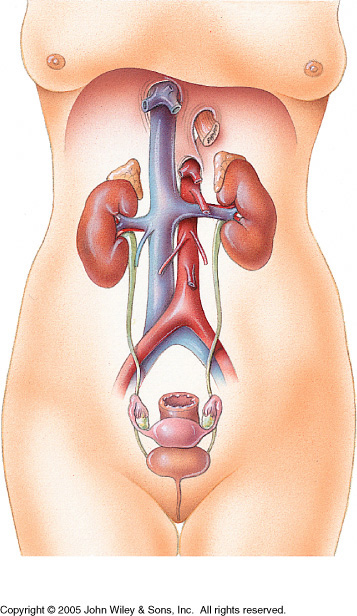
Bladder management after spinal cord injury

SPINAL CORD MEDICINE
EDUCATIONAL MATERIALS FOR PATIENT AND FAMILY
BLADDER MANAGEMENT FOLLOWING SPINAL
CORD INJURY/IMPAIRMENT
Frazier Rehab Institute
DISCLAIMER
The information contained herein is intended to be used in accordance with the
treatment plan prescribed by your physician and with the prior approval of your
physician. You should not begin using any of the information and/or methods
described in these publications until you have consulted your physician. Jewish
Hospital & St. Mary's HealthCare, Inc. D.B.A. Frazier Rehab Institute, its affiliates,
associates, successors and assigns, as well as its trustees, officers, directors, agents
and employees are not liable for any damages resulting from the use of this
publication.
COPYRIGHTED MATERIALS
The Spinal Cord Medicine Handbook for Patient and Family and related Educational
Materials are copyrighted. You may make single copies of these materials for
individual use only. Any alteration of the original copyrighted materials if prohibited.
Direct all inquiries to the Spinal Cord Medicine Program at Frazier, 1-866-540-7719 or
502-582-7495. Frazier Rehab and Neuroscience Center, 220 Abraham Flexner Way,
Frazier Rehab Institute
Bladder Management After
Spinal Cord Injury
Belinda N. Coyle, RN, BSN, CRRN
Spinal Cord Medicine Program
Frazier Rehab & Neuroscience Center
The Urinary System
Consists of the kidneys, ureters, bladder,
sphincters, & urethra
Major functions:
1. Regulates electrolytes to keep balance of
chemicals needed for body function
2. Removes waste products and excess H2O
(urine) from the blood via the kidneys
Frazier Rehab Institute
Process of Urination
Kidneys filter blood to remove waste
products & create urine
Urine travels thru the ureters to the bladderSensory nerves send messages up the spinal
cord to the brain when bladder is full
Frazier Rehab Institute
Process of Urination cont…
The brain then sends message down the
spinal cord to the bladder telling it to empty
The sphincter muscles relax, the bladder
muscles tighten to push urine from the bladder, & the urine leaves the body thru the urethra
Frazier Rehab Institute

The Urinary System
Frazier Rehab Institute
Urination After SCI
Messages/signals from the bladder to the
brain and vice versa become disrupted or lost completely due to the SCI
Neurogenic BladderThe level of injury of the spinal cord will
determine how urination will occur
Frazier Rehab Institute
Spastic Bladder (above T12- L1)
Also called reflex or Reflexes are
hyperactive bladder
triggered to let urine
Occurs with upper
flow but it may occur when you are
motor neuron injuries
The bladder fills,
The brain does not
stretches, pushes out
get the messages to
on nearby nerves that
tell you the "right"
send signals to the
Frazier Rehab Institute
Flaccid Bladder (below L1-L2)
Also called areflexic
Signals are not able
or "floppy" bladder
to reach the spinal
Occurs with lower
cord; bladder does
motor neuron injuries
not get the message
The bladder fills,
Bladder will become
stretches, & pushes
too full & urine will
out on nearby nerves that send signals to
leak out (may back
up into kidneys and can cause problems)
Frazier Rehab Institute
A Bladder Management
Programs May Include:
Indwelling catheter
(Crede' maneuver,
Suprapubic catheter
Valsalva, suprapubic
External catheter
Behavioral strategies
Incontinence devicesManual techniques to
Frazier Rehab Institute
Foley—catheter that remains in the bladder
& continuously empties urine into a drainage bag/device.
Small balloon at the end of the catheter is
filled with normal saline to keep it in the bladder.
Area around catheter should be cleaned at
least 1-2 times daily & catheter changed at least once per month
Increases risk of infection
Frazier Rehab Institute
Catheter surgically inserted into bladder
through the abdomen (stomach) that continuously empties urine into drainage bag/device.
Can be sutured (stitched) to skin &/or
balloon filled with normal saline used to hold in place in the bladder
Insertion site should be cleaned a couple
times daily & catheter changed every 1-2 months.
Increases risk of infection
Frazier Rehab Institute
Also known as "in & out" catheterizationCatheter inserted into bladder which drains
urine into collection device and then the catheter is removed
Typically performed about every 4-6 hours
around the clock (varies person to person)
Preferred over Foley because there is less
risk of infection
Frazier Rehab Institute
Also known as Texas or condom cathetersBeneficial for males who experience
spontaneous voiding
Fits over penis (much like a condom) &
hooks to drainage bag to keep you dry
Adhesive on the condom catheters holds the
catheters in place
Frazier Rehab Institute
Because of their anatomy, the only available
external option for a female would be in the form of an incontinence pad or brief.
Frazier Rehab Institute
Choosing Incontinence
Devices
Many different kinds of catheters available
Insurance benefits vary person to person
Can be purchased off Internet or at a local
drug store/pharmacy
Your rehab team can help you choose which
device(s) would work best for you
Frazier Rehab Institute
Timed toileting/voidsPelvic muscle exercises (Kegel)Electrical stimulation (stress or urge
incontinence problems only)
Frazier Rehab Institute
Medications for Bladder
Management
Anticholinergics—help
Cholenergics—help
prevent bladder spasms;
bladder contract;
promotes emptying (ex.
(examples Ditropan,
Oxytrol, Detrol, Bentyl)
Alpha blockers—relax
Alpha adrenergics—
muscles at base of
increase pressure on
bladder; promotes
bladder neck; promote
emptying (ex. Flomax,
Uroxatral, Minipress,
Hytrin, Cardura)
Frazier Rehab Institute
Mitrofanoff procedure: requires surgery to
construct a new passageway for urine using the appendix tissue; passageway allows catheter to pass through the abdomen and directly into bladder. It is good for women & those w/decreased hand function.
Bladder augmentation: surgical enlargement
of bladder; reduces need for frequent caths
Frazier Rehab Institute
Surgical Procedures cont…
Sphincerotomy: allows easier urine flow by
reducing pressure on sphincter; may affect ability to have reflex erection; usually not done on women.
Frazier Rehab Institute
Clean Intermittent
Catheterization
Technique used in home setting; a sterile
technique is used in the healthcare setting
Equipment needed: clean catheter, water-
based lubricant, washcloths or baby wipes, clean tray, and antiseptic soap
Can be performed lying down (in bed) or in
a seated position (on toilet/BSC or in wheelchair)
Frazier Rehab Institute
Clean IC cont…
Wash hands with soap & waterClean genital area with baby wipe or damp
washcloth and soap
*Males clean from tip to base of penis
*Females clean front to back
Lubricate catheter & position tray between
legs (point end of catheter toward toilet/BSC if seated)
Frazier Rehab Institute
Clean IC cont…
Insert catheter into meatus until urine flows
& allow urine to drain
When urine stream starts to trickle, massage
abdomen (Crede' maneuver)
Slowly remove catheter when urine is no
longer flowing out
Place used catheter in a storage container to
be cleaned later or discard if one-time use
Inspect urine for color, amount, odor, or
sediment (should generally be clear to light yellow)
Frazier Rehab Institute
Clean IC cont…
Rinse genital area with baby wipe or damp
Always wash your hands when finished!
Frazier Rehab Institute
Cleaning Catheters at Home
After using the catheter, wash & rinse inside
and out with soap and water
Dry on clean towel, making sure to drain
inside of catheter
Inspect catheters after each use and after
Discard those that are damaged & store the
Frazier Rehab Institute
Cleaning Catheters at Home
cont…
Those with frequent Urinary Tract Infections
(UTIs) or if you have a current UTI, you may want to alter the cleaning technique a little
After cleaning and rinsing with soap & water,
you will boil the catheters on the stovetop for 15-20 minutes
Drain, dry, and store as described before
Frazier Rehab Institute
Urinary Tract Infection (UTI)
Bacteria that multiply in the urinary tract can
cause an infection
Possible signs & symptoms include: cloudy
&/or foul smelling urine, increase in mucous or sediment, blood in urine, pain or burning with urination, increase in bladder spasms, increase in frequency of urination or incontinence, low back or flank pain, elevated temp/fever, chills, nausea/vomiting
Frazier Rehab Institute
Prevention of UTI: Things to Do
Proper fluid intake (8-10 glasses of liquid per
day, preferably water)
Routine bladder emptying (keep on bladder
management schedule; volumes should not to exceed 400-500ml at once)
Good hygiene (wash hands & keep skin
around genitals clean)
Frazier Rehab Institute
Prevention of UTI: Things to Do
Proper positioning & draining of collection
device (leg bag/bedside drainage bag)
Daily cleaning of drainage devices & proper
cleaning of catheters (after each use)
Regular check-ups with your healthcare
provider (at least yearly)
Frazier Rehab Institute
Detection & Treatment of UTI
Call MD if you suspect UTIMay need urine specimen (UA C&S) to
determine if true infection
Treatment may include use of antibioticsContinue to always use preventative
Frazier Rehab Institute
It may take time & effort, but proper bladder
management can be achieved in those with spinal cord injuries.
Try to keep a healthy urinary system by
staying educated, sticking to a regimen, and using preventative measures.
Follow the recommendations of your
healthcare providers!
Frazier Rehab Institute
Questions or Concerns?
Frazier Rehab Institute
Spinal Cord Medicine Clinic
Belinda Coyle, SCMP Nurse Coordinator
Bladder care. (n.d.). Retrieved July 25, 2006, from
Bladder care. (n.d.). Retrieved July 25, 2006, from
Bladder care. Chapter in Patient and Family Handbook for Spinal
Cord Injury. Frazier Rehab Institute, 2009. Available under Education section at
Fine, C.K., & Nelson, A. (Eds.). (2001). Nursing practice related to
spinal cord injury and disorders: A core curriculum. New York:Eastern Paralyzed Veterans Association.
Haeman, S.P. (2002). Rehabilitation nursing: Process application
and outcomes, 3rd edition. Mosby.
Maddox, Sam. (2003). Paralysis Resource Guide. New Jersey:
Christopher Reeve Paralysis Foundation.
Frazier Rehab Institute
Source: http://www.kentuckyonehealth.com/documents/frazier/Bladder%20Management%201%2009.pdf
Optimal Competitive Online Ray Search with an Tom Kamphans and Elmar Langetepe University of Bonn, Institute of Computer Science I omerstraße 164, 53117 Bonn, Germany Abstract. We consider the problem of finding a door along a wall witha blind robot that neither knows the distance to the door nor the direc-tion towards of the door. This problem can be solved with the well-known doubling strategy yielding an optimal competitive factor of 9with the assumption that the robot does not make any errors duringits movements. We study the case that the robot's movement is erro-neous. In this case the doubling strategy is no longer optimal. We presentoptimal competitive strategies that take the error assumption into ac-count.
06.02.2005 21:50 Uhr Rundbrief Oktober 2000 Inhaltsverzeichnis1. Vorwort (1. Vorsitzender) 2.1 Vorstellung neuer Landesstellenleiter Baden-Württemberg Dr. med. M. Abel 2.2 Zweite Landesstellenleiterin Nordrhein-Westfalen Dr. med. Monika Herma-Boeters 2.3 Verabschiedung Landesstellenleiter Baden-Württ. Prof. Dr. med. Karl Mann 3. Bericht über die Jahrestagung 16. - 18. 6. 2000 3.1 Vortrag Dr. Ohm 3.2 Vortrag Dr. Clausen 3.3 Vortrag Dr. Stetter 4. Leitlinie Hypnose der DGÄHAT 5. Mitgliederversammlung der DGÄHAT am 19.06.2000 5. 1 Laudatio Prof. Dr. med. Dietrich Langen 5. 2 Laudatio Dr. med. Herbert Mensen 6. Bericht über die Treffen der korporativen Mitglieder der AÄGP 7. Informationsaustausch der Vertreter der Methoden AT/Hypnose/Hypnotherapie in Lindau am 19.04.2000 8. Beteiligung unserer Fachgesellschaft beim 15. Internationalen Kongress für Hypnose in München 8.1 Gründung eines wissenschaftlichen Beirates der deutschsprachigen Hypnose-Gesellschaften 9. Neue Mitglieder 10. Verstorbene Mitglieder 11. Zertifikate 12. Veröffentlichungen von Mitgliedern der Gesellschaft 12. 1 Buchbesprechung "Hypnose-Trance-Suggestion" von Dr. med. Peter Halama (W.-R. Krause) 12. 2 Buchbesprechung "Progressive Relaxation für Kids" von Dipl.-Psych. Dr.Dietmar Ohm (C. Derra) 13. Aktuelle Information zur STÄKO am 18. 10. 2000 14. Termine/Tagungen/internationale Kongresse






